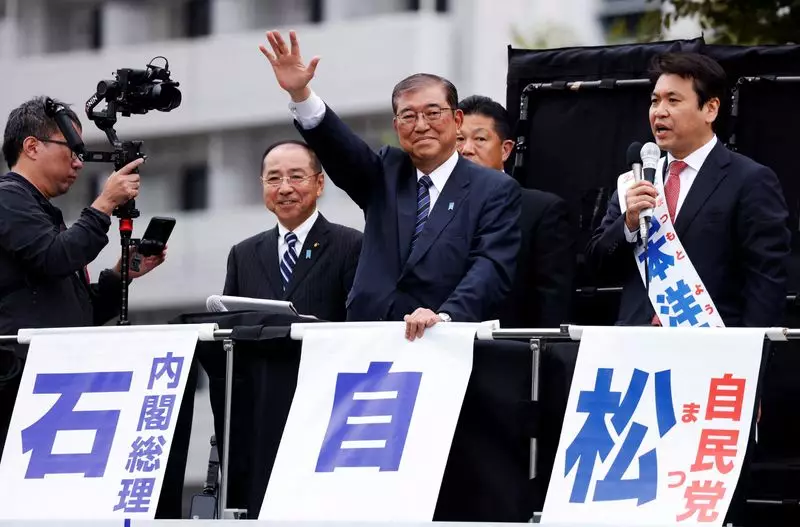In a noteworthy turn of events, recent exit polls from Japan’s general election indicate that Prime Minister Shigeru Ishiba’s coalition may be on the brink of losing its parliamentary majority. This development has paved the way for potential political maneuvering among various parties, which could significantly alter the landscape of governance in Japan. This article will scrutinize the ramifications of these electoral outcomes and the principal players poised to impact the future of Japanese politics.
Historically dominant in Japan’s postwar political scene, the Liberal Democratic Party (LDP) has faced unprecedented challenges in this election cycle. Despite its longstanding influence, the party is now grappling with public frustration, primarily due to a protracted political funding scandal. Voter anger was exacerbated by the fact that more than 40 lawmakers were allowed to represent the party despite failing to disclose political donations. As a result, Ishiba’s coalition enters a precarious situation, with predictions that it may fall from its previous 247 seats to between 153 and 219. This is starkly below the necessary threshold of 233 seats to retain a majority in the lower house.
Moreover, the LDP’s struggles are also compounded by broader economic dissatisfaction, particularly with rising prices, an issue that has resonated deeply with the electorate. As the party has traditionally prided itself on economic stability and growth, this failure to address economic concerns effectively highlights a crucial shift in public sentiment.
The LDP’s coalition partner, Komeito, has played a pivotal role in maintaining parliamentary control for nearly two decades. Tied to Sokka Gakkai, Japan’s largest lay-Buddhist organisation, Komeito has historically facilitated the LDP’s electoral campaigns by leveraging its extensive network of volunteers. In return for its support, Komeito has typically enjoyed significant representation in the cabinet and influence over specific policy areas.
However, Komeito has exhibited a reticence to abandon Japan’s post-World War II pacifist principles, especially in light of recent discussions on military expansion and revised constitutional provisions regarding defense. With its prospects of increasing its current representation of 32 seats possibly to around 35, Komeito’s future insight must reconcile the desire for security and the adherence to pacifism, a balancing act that may define its role in any forthcoming coalition government.
The Constitutional Democrats Rising
On the other side of the aisle, the Constitutional Democratic Party of Japan (CDPJ) emerges as a significant opposition force, looking to capitalize on the LDP’s vulnerabilities. Led by former Prime Minister Yoshihiko Noda, the CDPJ has focused its campaign on holding the LDP accountable for its funding scandals while proposing robust measures to combat inflation, which is a pressing concern for many Japanese citizens.
Polls indicate that the CDPJ is on track to double its seating count from 98, potentially positioning itself as a primary contender for forming a government should the LDP and Komeito coalition fail to secure a majority. The feasibility of the CDPJ forming a government with other left-leaning parties could signal a substantial shift in Japan’s political direction, challenging the long-standing dominance of the LDP.
Amidst this electoral turmoil, the Japan Innovation Party, led by the controversial figure Nobuyuki Baba, and the Democratic Party for the People (DPP) are also critical players to consider. With its roots in the industrial city of Osaka, the Japan Innovation Party advocates for a leaner government and stricter donation laws while supporting increased defense budgets. Having previously held 44 seats, the party anticipates a gain, reinforcing its position as a right-wing force aligned with the LDP on security matters.
Conversely, the DPP, created by former members of the Democratic Party, is emerging as a potential kingmaker, advocating for tax cuts and health insurance reforms, even after starting the election with only seven seats. The projections of the DPP expanding to as many as 33 seats suggest that their policy positions could inject new life and direction into political negotiations moving forward.
The recent election results may very well signify a profound shift in Japan’s political dynamics. The waning power of the LDP, combined with the rising opposition and new political forces, could lead to a reconfiguration of alliances and governance strategies. As parties begin to navigate these uncharted waters post-election, the implications for policy development and political stability in Japan will be closely monitored by both domestic and international observers. Ultimately, how these entities align will not only dictate the political landscape but also the socio-economic trajectory of Japan in the years to come.

